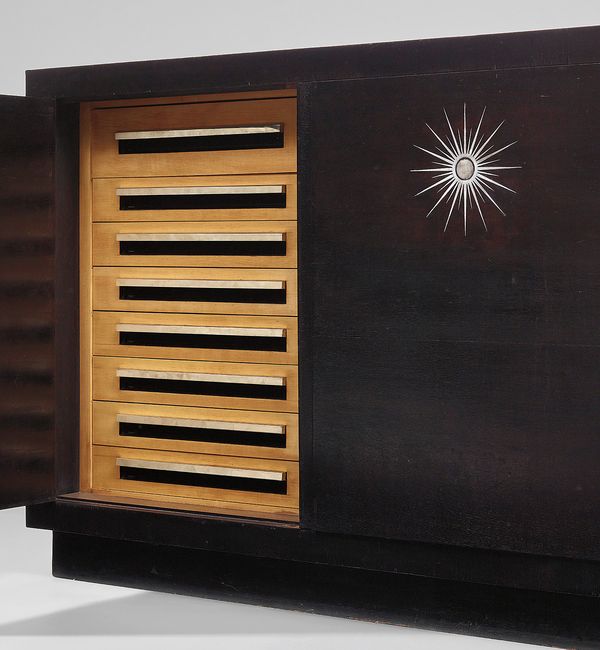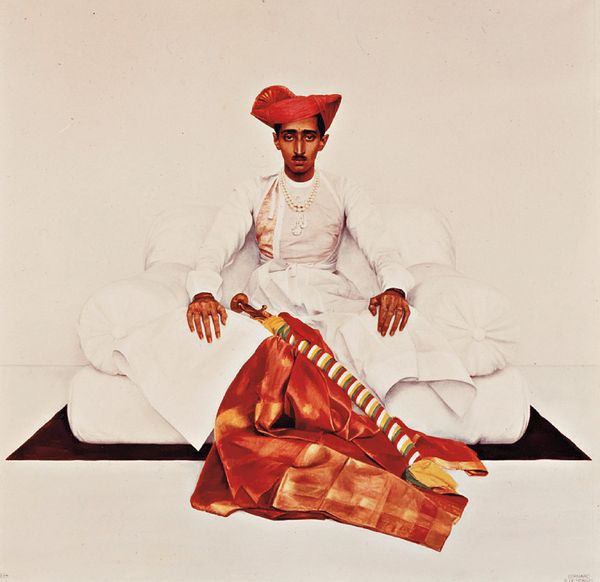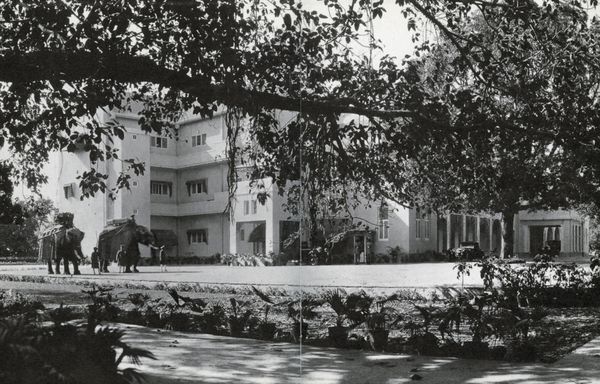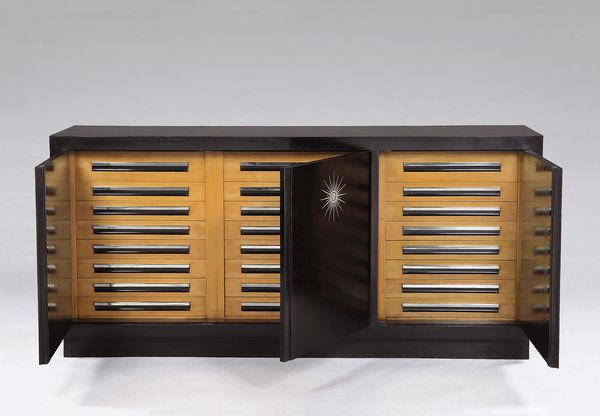Eckart Muthesius Important sideboard, from the Maharaja of Indore's Banquet Hall, Manik Bagh Palace, Indore, circa 1931
In 1926, Yeshwant Rao Holkar II assumed the position of Maharaja of Indore, following his father's deposition and exile to France. He was only 22 years old when he returned to India and took on ruling responsibilities. Having completed his studies in England and traveled throughout Europe, he brought with him a modern perspective to his leadership as well as to the design and decoration of his palace, Manik Bagh, or "Garden of Precious Stones."
Bernard Boutet de Monvel, The Maharaja of Indore in traditional Maratha Dress, circa 1929. Artwork © 2019 Artists Rights Society (ARS), New York/ ADAGP, Paris.
He had begun to develop a network of like-minded visionaries in the fields of art, architecture and fashion. Foremost among his European connections was the German architect Eckart Muthesius, whom he had befriended while studying at Oxford in the 1920s. The son of the renowned architect Hermann Muthesius, the younger Muthesius was enmeshed in the progressive architecture and design of his father's generation and captivated by the budding International Style architecture of his own. The Maharaja and the architect shared a similar frame of reference and affinity for the European avante-garde.
Yeshwant Rao thus hired his friend to design his new palace and the two worked closely together to build a ground-breaking homage to the Maharaja's past, present and future legacy. Structured like a traditional Mughal palace around a central garden, Manik Bagh was otherwise modernist in every way, though the most functionalist aspect–the pitched roofs necessary to withstand monsoons–were so offensive to the Maharaja that the sketches used to publicize the project depicted it with flat roofs instead. Local brick and rare woods from the forests of Indore were employed to striking effect. The finishes and features were as modern and extravagant as technology and budget could bear, with air-conditioning (the first in India), metal-framed and tinted windows, hydraulic doors, machined marble and modern plumbing throughout the enormous structure.
The Maharaja and the architect shared a similar frame of reference and affinity for the European avante-garde.
Eckart Muthesius, Exterior of the Manik Bagh Palace. Artwork © 2019 Artists Rights Society (ARS), New York/VG Bild Kunst, Bonn.
Most notably, the palace was filled with exceptional pieces of 1920s and 1930s modernist furniture by U.A.M. (Union des artistes modernes) members such as Le Corbusier and René Herbst, Bauhaus architects like Marcel Breuer and Ludwig Mies van der Rohe and the Art Deco designer Émile-Jacques Ruhlmann. A number of these works have gone on to become icons of twentieth-century design, setting record prices at auction, including Eileen Gray's Transat chair from the Maharaja’s bedroom (sold at Phillips, New York, “The Collector: Icons of Design,” December 16, 2014) and Ivan da Silva Bruhns' enormous carpet in the palace's red and black color scheme (sold at Phillips, London, “Modern Masters: Design Evening Sale,” April 27, 2016).
Eileen Gray The Maharaja of Indore's "Transat" chair, from Manik Bagh Palace, 1930. Sold for $1,538,500 at Phillips New York in 2014.
Photographs taken by Muthesius upon completion of the project show that this 1931 sideboard was originally situated, along with another longer example, in the magnificent ground floor banquet hall. Imposing in its austerity, the room included an expansive dining table that stretched the length of the room and featured illuminated recesses for floral arrangements and tableware by Jean Puiforcat. The stained walnut veneers of both sideboards were inlaid with white metal marquetry in sun motifs, representing the Rajput ancestry that the Holkars of Indore claimed. The motif also appears within the monogram that Muthesius redesigned for Yeshwant Rao Holkar.
Each cabinet opens to eight sycamore drawers with nickel silver handles.
In the 1970s, the Manik Bagh Palace was rediscovered, shortly before the Maharaja's privileges were revoked by the Indian government. Muthesius had long ago been forced to leave India during the Second World War, and the Maharaja had rarely occupied the palace in the intervening years. The palace went to the state, and in 1980 Sotheby’s Monaco famously sold a portion of its contents.
The present cabinet, however, was not included in the Monaco auction and has remained in the same private collection since the 1980s.





